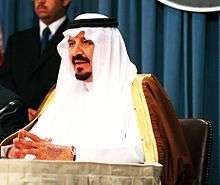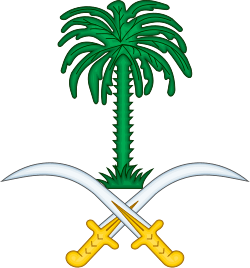Saudi Arabia–United States relations
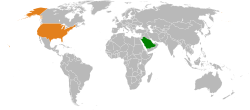 | |
Saudi Arabia |
United States |
|---|---|
| Diplomatic Mission | |
| The Royal Embassy of Saudi Arabia, Washington, D.C., United States | Embassy of the United States, Riyadh, Saudi Arabia |
| Envoy | |
| Saudi Arabian Ambassador to the United States Khalid bin Salman bin Abdulaziz Al Saud |
U.S. Ambassador to Saudi Arabia Joseph W. Westphal (de facto) Christopher Henzel (Chargé d'Affaires) |
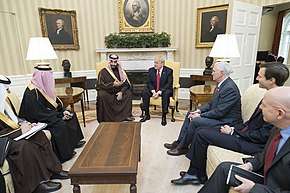
Saudi Arabia–United States relations refers to the bilateral relations between the Kingdom of Saudi Arabia and the United States of America. It is a Special Relationship, which began in 1933 when full diplomatic relations were established. Despite the differences between the two countries—an ultraconservative Islamic absolute monarchy, and a secular, constitutional republic—the two countries have been allies. Former Presidents George W. Bush and Barack Obama have close and strong relations with senior members of the Saudi Royal Family.[1]
Ever since the modern US–Saudi relationship began in 1945, the United States has been willing to overlook many of the kingdom's more controversial aspects as long as it kept the oil flowing and supported U.S. national security policies.[2] Since World War II, the two countries have been allied in opposition to Communism, in support of stable oil prices, stability in the oil fields and oil shipping of the Persian Gulf, and stability in the economies of Western countries where Saudis have invested. In particular the two countries were allies against the Soviets in Afghanistan and in the expulsion of Iraq from Kuwait in 1991. The two countries have been in disagreement with regard to the State of Israel, as well as the embargo of the U.S. and its allies by Saudi Arabia and other Middle East oil exporters during the 1973 oil crisis (which raised oil prices considerably), the 2003 US-led invasion of Iraq (which Saudi Arabia opposed), aspects of the "War on Terror", and what many in the U.S. see as the pernicious influence of Saudi Arabia after the September 11 attacks. In recent years, particularly the Barack Obama administration, the relationship between the two countries became strained and witnessed major decline.[3][4][5] However, the relationship was strengthened by President Donald Trump's trip to Saudi Arabia in May 2017, which was his first overseas trip since becoming President of the United States.[6][7][8][9]
Despite the strong relationship between the two countries, opinion polls between the two nations show negative feelings between the American people and Saudi people in recent years, particularly American feelings towards the desert kingdom. A poll of Saudis by Zogby International (2002) and BBC (between October 2005 and January 2006) found 51% of Saudis had hostile feelings towards the American people in 2002;[10] in 2005/2006, Saudi public opinion was sharply divided with 38% viewing U.S. influence positively and 38% viewing U.S. influence negatively.[8] As of 2012, Saudi Arabian students form the 4th largest group of international students studying in the United States, representing 3.5% of all foreigners pursuing higher education in the US.[11] A December 2013 poll found 57% of Americans polled had an unfavorable view of Saudi Arabia and 27% favorable.[9]
History
%2C_14_February_1945_(USA-C-545).jpg)
Early history (recognition)
Although King Abdulaziz Al Saud, Ibn Saud as an appellation, the founder of Saudi Arabia in 1901, had an excellent relationship with the British who defended Saudi Arabia from the Turks, he eventually developed even closer ties with the United States. After unifying his country, on September 28, 1928, Bin Saud set about gaining international recognition for Saudi Arabia. Britain was the first country to recognize Saudi Arabia as an independent state, as the British had provided protection of Saudi territories from the Turks for many years (Wafa, 2005). Saud also hoped to be recognized by the US, which at that time had no interest in Saudi Arabia. Initially, his efforts were rebuffed, but Washington eventually came around, promoted by the fact that Al Saud had obtained recognition from many nations. In May 1931 the U.S. officially recognized Saudi Arabia by extending full diplomatic recognition.[12][13] At the same time Ibn Saud granted a concession to the U.S. company, Standard Oil of California, allowing them to explore for oil in the country's Eastern Province, al-Hasa.[13] The company gave the Saudi government £35,000 and also paid assorted rental fees and royalty payments.
In November 1931, a treaty was signed by both nations which included favored nation status. The relationship was still weak, however, as America did not have an interest in establishing missions in Saudi Arabia: at the time, Saudi affairs were handled by the U.S. delegation in Cairo, Egypt, and did not send a resident ambassador to the country until 1943.[12]
Foundation of ARAMCO
After the promises that had been made by American oil explorers that Saudi Arabia could have a very good chance of finding oil, Al Saud accepted the American offer of exploration, because he was hoping that his land could have valuable materials that would support the country's economy. In May 1933 the California Arabian Standard Oil Company (CASOC), later called the Arab American Company (ARAMCO), had started the exploration in the country with large area to explore (Alnabrab, 2008). Although the imported oil was not very important for the U.S. at the time, Washington seemed hungry for the Saudi oil since their confidence in finding oil in Saudi Arabia had greatly grown, which resulted in stronger relations with Saudi Arabia (Irvine, 1981).
CASOC Struck oil near Dhahran, but production over the next several years remained low—only about 42.5 million barrels between 1941 and 1945; less than 1% of the output in the United States over the same time period. CASOC was later renamed the Arabian-American Oil Company (Aramco). The agreement between the company and the Saudi kingdom was modified several times over the years. In 1950, Saudi Arabia and Aramco agreed to a 50–50 profit-sharing arrangement, and a series of agreements between 1973 and 1980 resulted in the Saudis' regaining full control of the company. In 1988, Fahd of Saudi Arabia issued a royal decree establishing the Saudi Arabian Oil Company, known as Saudi Aramco, to replace Aramco.
World War II
As the U.S.–Saudi relationship was growing slowly, World War II was beginning its first phase. The U.S. was deeply involved in World War II, and as a result, US-Saudi relations were put on the 'back burner'. This negligence left Saudi Arabia vulnerable to attack. Italy, an Axis power, bombed a CASOC oil installation in Dhahran crippling Saudi Arabia's oil production.[12] This attack left Bin Saud scrambling for to find an external power that would protect the country, fearing further attacks that would most likely cease the country's oil production and the flow of pilgrims coming into Makkah to perform Hajj, the base of the Saudi power and economy at that time (Wafa, 2005).
However, as World War II progressed, the United States began to believe that Saudi oil was of strategic importance. As a result, in the interest of national security, the U.S. began to push for greater control over the CASOC concession. On 16 February 1943, President Franklin D. Roosevelt declared that "the defense of Saudi Arabia is vital to the defense of the United States", thereby making possible the extension of the Lend-Lease program to the kingdom. Later that year, the president approved the creation of the state-owned Petroleum Reserves Corporation, with the intent that it purchase all the stock of CASOC and thus gain control of Saudi oil reserves in the region. However, the plan was met with opposition and ultimately failed. Roosevelt continued to court the government, however—on 14 February 1945, he met with King Ibn Saud aboard the USS Quincy, discussing topics such as the countries' security relationship and the creation of a Jewish country in the Mandate of Palestine.
Bin Saud therefore approved the US's request to allow the U.S. air force to fly over and construct airfields in Saudi Arabia. The oil installations were rebuilt and protected by the U.S.,[12] the pilgrims' routes were protected (Wafa, 2005), and the U.S. gained a much needed direct route for military aircraft heading to Iran and the Soviet Union.[12] The first American consulate was opened in Dhahran in 1944.[14]
After World War II
In 1945, after World War II, Saudi citizens began to feel uncomfortable with U.S. forces still operating in Dhahran. In contrast, Saudi government and officials saw the U.S. forces as a major component of the Saudi military defense strategy.[15] As a result, Bin Saud balanced the two conflicts by increasing the demands on U.S. forces in Dhahran when the region was highly threatened and lowering it when the danger declined (Alnabrab, 1994). At this time, due to the start of the Cold War, the U.S. was greatly concerned about Soviet communism and devised a strategy of 'containing' the spread of communism within Arabian Peninsula, putting Saudi security at the top of Washington's list of priorities.[16] Harry S. Truman's administration also promised Bin Saud that he would protect Saudi Arabia from Soviet influence. Therefore, the U.S. increased its presence in the region to protect its interest and its allies.[15] The security relationship between Saudi Arabia and the U.S. was therefore greatly strengthened at the start of the 'cold war'.[17]
In 1950, Saudi Arabia and Aramco agreed to a 50–50 profit-sharing arrangement.
In 1951, under a mutual defense agreement, the U.S. established a permanent U.S. Military Training Mission in the kingdom and agreed to provide training support in the use of weapons and other security-related services to the Saudi armed forces. The US Army Corps of Engineers assisted in the construction of military installations in the kingdom. This agreement formed the basis of what grew into a longstanding security relationship. Two years later, King Abdulaziz died and was succeeded by his son, Crown Prince Saud, who was known for his reputation as a spendthrift. Under King Saud, the kingdom's treasury diminished rapidly and he was forced to turn over direct control of government affairs to his half-brother Faisal from 1958 to 1961. In 1964, the royal family and religious leadership forced Saud to abdicate in favor of Faisal.
King Saud comes to power (1953)
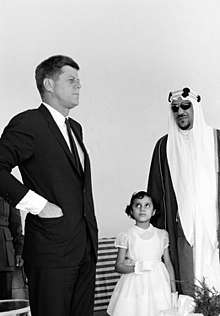
In the late 1950s, King Saud, the eldest son of King Abdulaziz, came to power after his father's death. During Saud's time the U.S.–Saudi relations had faced many obstacles concerning the anti-communism strategy. President Dwight D. Eisenhower's new anti-Soviet alliance combined most of "the kingdom's regional rivals and foes", which heightened Saudi suspicions.[12] For this reason, in October 1955, Saud had joined the pro-Soviet strategy with Egyptian president Gamal Abdel Nasser.[15] Furthermore, Saud dismissed the U.S. forces and replaced them by Egyptian forces. Thus, this act had sparked and innovated a new and a large conflict in the relationship. But in 1956, during the Suez crisis, Saud began to cooperate with the U.S. again after Eisenhower's opposition of the Israeli, British, and French plan to seize the canal. Eisenhower opposed the plan because of anti-Soviet purposes, but King Saud had admired the act and decided to start cooperating with the U.S.[15] As a result, Egyptian power greatly declined while US-Saudi relations were simultaneously improving.
Cold War and Soviet containment
In 1957, Saud decided to renew the U.S. base in Dhahran. In less than a year, after the Egyptian–Syrian unification in 1958, Egypt's pro-Soviet strategy had returned to power. Saud had once again joined their alliance, which declined the US-Saudi relationship to a fairly low point especially after he announced in 1961 that he changed his mind on renewing the U.S. base.[18] In 1962, however, Egypt attacked Saudi Arabia from bases in Yemen during the 1962 Yemeni revolution because of Saudi Arabia's Anti-revolution propaganda, which made Saud seek the U.S. support. President John F. Kennedy immediately responded to Saud's request by sending U.S. warplanes in July 1963 to the war zone to stop the attack which was putting U.S. interests at risk.[15] At the end of the war, shortly before Prince Faisal became king, the relationship rebuilt itself to become healthy again.[18]
As the United Kingdom withdrew from the Gulf region in the late 1960s and early 1970s, the U.S. was reluctant to take on new security commitments. Instead, the Nixon administration sought to rely on local allies to "police" American interests (see Nixon Doctrine). In the Gulf region, this meant relying on Saudi Arabia and Iran as "twin pillars" of regional security. Whereas in 1970 the U.S. provided less than $16 million to Saudi Arabia in military aid, that number increased to $312 million by 1972.[19] As part of the "twin pillars" strategy, the U.S. also attempted to improve relations between the Saudis and the Iranians, such as by persuading Iran to remove its territorial claim to Bahrain.[20]
Oil embargo and energy crises
In November 1964, Faisal became the new king after the conflicts he had with his brother Saud, the erstwhile king. The US, on the other hand, was not sure about the outcome of such unplanned change in the Saudi monarchy. Faisal, however, continued the cooperation with the US until October 20, 1973. Then came the low point of the relationship before 9/11, as Faisal decided to contribute in an oil embargo against the US and Europe in favor of the Arab position during the Yom Kippur War. That caused an energy crisis in the US.
"America's complete Israel support against the Arabs makes it extremely difficult for us to continue to supply the United States with oil, or even remain friends with the United States," said Faisal in an interview with international media.[21]
Despite the tensions caused by the oil embargo, the U.S. wished to resume relations with the Saudis. Indeed, the great oil wealth accumulated as a result of price increases allowed the Saudis to purchase large sums of American military technology. The embargo was lifted in March 1974 after the U.S. pressured Israel into negotiating with Syria over the Golan Heights. Three months later, "Washington and Riyadh signed a wide-ranging agreement on expanded economic and military cooperation." In the 1975 fiscal year, the two countries signed $2 billion worth of military contracts, including an agreement to send Saudi Arabia 60 fighter jets.[22] The Saudis also argued (partially on behalf of American desires) to keep OPEC price increases in the mid-1970s lower than Iraq and Iran initially wanted.[19] As part of the "twin pillars" strategy, the U.S. also attempted to improve relations between the Saudis and the Iranians, such as by persuading Iran to remove its territorial claim to Bahrain.[23]
The Saudis' increase of oil production to stabilize the oil price and the support of anti-communism have all contributed to closer relations with the U.S.[18] In January 1979, the U.S. sent F-15 fighters to Saudi Arabia for further protection from communism.[18] Furthermore, the U.S. and Saudi Arabia were both supporting anti-communist groups in Afghanistan and struggling countries, one of those groups later became known as the Al-Qaida terrorist organization.[24]

Government purchases
After the Cold War the U.S.–Saudi relations were improving. The U.S. and U.S. companies were actively engaged and paid handsomely for preparing and administrating the rebuilding of Saudi Arabia. Saudi Arabia transferred $100 billion to the United States for administration, construction, weapons, and in the 1970s and 1980s higher education scholarships to the U.S.[25] During that era the U.S. built and administrated numerous military academies, navy ports, and Air Force military airbases. Many of these military facilities were influenced by the U.S., with the needs of cold war aircraft and deployment strategies in mind. Also the Saudis purchased a great deal of weapons that varied from F-15 war planes to M1 Abrams main battle tanks that later proved useful during the Gulf War.[25] The U.S. pursued a policy of building up and training the Saudi military as a counterweight to Shiite extremism and revolution following the revolution in Iran. The U.S. provided top of the line equipment and training, and consulted the Saudi government frequently, acknowledging them as the most important Islamic leader in that part of the world, and a key player in the U.S. security strategy.
The Gulf War
Iraq's invasion of Kuwait in August 1990 led to the Gulf War, during which the security relationship between the US and Saudi Arabia was greatly strengthened. Concurrently with the US invasion, King Fahd declared war against Iraq. The U.S. was concerned about the safety of Saudi Arabia against Saddam's intention to invade and control the oil reserves in the region. As a result, after King Fahd's approval, President Bush deployed a significant amount of American military forces (up to 543,000 ground troops by the end of the operation) to protect Saudi Arabia from a possible Iraqi invasion; this operation was called Desert Shield. Furthermore, the U.S. sent additional troops in operation Desert Storm with nearly 100,000 Saudi troops sent by Fahad to form a US-Saudi army alliance, along with troops from other allied countries, to attack Iraqi troops in Kuwait and to stop further invasion.[26] During Operation Desert Storm Iraqi troops were defeated within four days, causing the Iraqis to retreat back to Iraq.
Operation Southern Watch
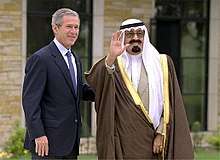
Since the Gulf War, the U.S. had a continued presence of 5,000 troops stationed in Saudi Arabia – a figure that rose to 10,000 during the 2003 conflict in Iraq.[27] Operation Southern Watch enforced the no-fly zones over southern Iraq set up after 1991, and the country's oil exports through the shipping lanes of the Persian Gulf are protected by the US Fifth Fleet, based in Bahrain.
The continued presence of U.S. troops in Saudi Arabia was one of the stated motivations behind the September 11 attacks,[27] as well as the Khobar Towers bombing.[28] In 2003, the U.S. withdrew most of its troops from Saudi Arabia, though one unit still remains.
2010 U.S. arms sale to Saudi Arabia
On October 20, 2010, U.S. State Department notified Congress of its intention to make the biggest arms sale in American history – an estimated $60.5 billion purchase by the Kingdom of Saudi Arabia. The package represents a considerable improvement in the offensive capability of the Saudi armed forces.[29]
The U.S. was keen to point out that the arms transfer would increase "interoperability" with U.S. forces. In the 1990–1991 Gulf War, having U.S.-trained Saudi forces, along with military installations built to U.S. specifications, allowed the American armed forces to deploy in a comfortable and familiar battle environment. This new deal would increase these capabilities, as an advanced American military infrastructure is about to be built.[30]
Foreign policy
Upon becoming regent in 2005, King Abdullah's first foreign trip was to China. In 2012 A Saudi-Chinese agreement to cooperate in the use of atomic energy for peaceful purposes was signed. Abdullah also welcomed Russian president Vladimir Putin to Riyadh in 2007, awarding him the kingdom's highest honor, the King Abdul Aziz Medal. Russia and Saudi concluded a joint venture between Saudi ARAMCO and LUKOIL to develop new Saudi gas fields. [31] [32]
Rift
.jpg)
Alwaleed bin Talal warned several Saudi ministers in May 2013 that shale gas production in the U.S. would eventually pose a threat to the kingdom's oil-dependent economy. Despite this, the two countries still maintained a positive relationship.[33]
In October 2013, Saudi intelligence chief Prince Bandar bin Sultan suggested a distancing of Saudi Arabia–United States relations as a result of differences between the two countries over the Syrian civil war and diplomatic overtures between Iran and the Obama administration.[34] The Saudis rejected a rotating seat on the UN Security Council that month (despite previously campaigning for such a seat), in protest of American policy over those issues.[35]
Saudi Arabia was cautiously supportive of a Western-negotiated interim agreement with Iran over its nuclear program. President Obama called King Abdullah to brief him about the agreement, and the White House said the leaders agreed to "consult regularly" about the U.S.'s negotiations with Iran.[36]
Controversies
First conflict
While the U.S.–Saudi relationship was growing, their first conflict began when the disorder broke between the Jews and Arabs in April 1936 in the British-administrated Palestine mandate. The U.S. favored the establishment of an independent Israeli state, but Saudi Arabia on the other hand, the leading nation in the Islamic and Arab world were supporting the Arab position which sparked up their first conflict. In other words, the U.S. oil interest in Saudi Arabia could be held hostage depending on the circumstances of the conflict.[12] U.S. president Franklin D. Roosevelt sent the king a letter indicating that it is true that the U.S. supports the establishment of a Jewish state in Palestine, but it is not in any way responsible for the establishment (Alnabrab, 2008). Bin Saud was convinced by the message that the U.S.–Saudi relations had begun to run smooth again. Moreover, in March 1938, CASCO made a big oil discovery in Saudi Arabia booming the oil industry in the country and coincidentally the U.S. became more interested in Saudi oil. As a result, on February 4, 1940, as the World War II was approaching, the U.S. had established a diplomatic presence in Saudi Arabia to have closer relations with the Saudis and to protect it from enemy hand; Bert Fish, former ambassador in Egypt was elected as the U.S. ambassador in Jeddah.[17]
September 11 attacks
On September 11, 2001, terrorist attacks on New York City and Washington, D.C. and in a field near Shanksville, Pennsylvania by four hijacked airplanes killed 2,977 victims and cost an estimated $150 billion in property and infrastructure damage and economic impact, exceeding the death toll and damage caused by the Japanese attack on Pearl Harbor 60 years earlier.[37] 15 of the 19 hijackers in the attacks came from Saudi Arabia, as did the leader of the hijackers' organization, (Osama bin Laden). In the U.S., there followed considerable negative publicity for, and scrutiny of, Saudi Arabia and its teaching of Islam,[38] and a reassessing of the "oil-for-security" alliance with the Al Saud.[39] [40] A 2002 Council on Foreign Relations Terrorist Financing Task Force report found that: “For years, individuals and charities based in Saudi Arabia have been the most important source of funds for al-Qaeda. And for years, Saudi officials have turned a blind eye to this problem.”[41]
In the backlash against Saudi Arabia and Wahhabism, the Saudi government was portrayed in the media, Senate hearings, and elsewhere as
a sort of oily heart of darkness, the wellspring of a bleak, hostile value system that is the very antithesis of our own. America's seventy-year alliance with the kingdom has been reappraised as a ghastly mistake, a selling of the soul, a gas-addicted alliance with death.[42]
There was even a proposal at the Defense Policy Board, (an arm of Department of Defense) to consider `taking Saudi out of Arabia` by forcibly seizing control of the oil fields, giving the Hijaz back to the Hashemites, and delegating control of Medina and Mecca to a multinational committee of moderate, non-Wahhabi Muslims.[43]
The Saudi government issued a statement on the day of the attacks calling them "regrettable and inhuman."[44] Saudi recognition to the Taliban (which worked with bin Laden) stopped and as of November 2001, the Bush administration continued to publicly praise Saudi support for the war on terrorism. However, published media reports have indicated U.S. frustration with Saudi inaction. Although 15 of the 19 hijackers were Saudi nationals, publicly the Saudis were not cooperating with Americans wanting to look at background files of the hijackers or interview the hijackers' families.
In Saudi Arabia itself, anti-American sentiment was described as "intense"[45] and "at an all-time high".[46]
A survey taken by the Saudi intelligence service of "educated Saudis between the ages of 25 and 41" taken shortly after the 9/11 attacks "concluded that 95 percent" of those surveyed supported Bin Laden's cause.[47] (Support for Bin Laden reportedly waned by 2006 and by then, the Saudi population become considerably more pro-American, after Al-Qaeda linked groups staged attacks inside Saudi Arabia.[48]) The proposal at the Defense Policy Board to `take Saudi out of Arabia` was spread as the secret US plan for the kingdom.[49]
In October 2001, The Wall Street Journal reported that Crown Prince Abdullah sent a critical letter to U.S. President George W. Bush on August 29. He warned that Saudi Arabia was being put in an untenable position by lack of US response to Israel-Palestinian violence, and reportedly wrote: "A time comes when peoples and nations part. We are at a crossroads. It is time for the United States and Saudi Arabia to look at their separate interests. Those governments that don't feel the pulse of their people and respond to it will suffer the fate of the Shah of Iran."[50]
For over a year after 9/11 Saudi Minister of the Interior (a powerful post whose jurisdiction included domestic intelligence gathering), Prince Nayef bin Abdul-Aziz Al Saud, insisted that the Saudi hijackers were dupes in a Zionist plot. In December 2002, a Saudi government spokesman declared that his country was the victim of unwarranted American intolerance bordering on hate.[51]
In 2003, several terror attacks targeted U.S. compounds, the Saudi ministry of interior, and several other places occurred inside Saudi Arabia. As a result of these attacks, the U.S. decided to redevelop Saudi law enforcement agencies by providing them with anti-terrorism education, the latest technologies, and by giving them a chance to interact with U.S. law enforcement agencies to gain efficient knowledge and power needed to handle terrorist cases and to enforce anti-terrorist laws.[15]
Although some analysts have speculated that Osama bin Laden, who in 1994 had his Saudi nationality revoked and expelled from Saudi Arabia, had chosen 15 Saudi hijackers on purpose to break up the U.S.–Saudi relations, as the U.S. was still suspicious of Saudi Arabia (PBS Frontline, 2005). The Saudi's decided to cooperate with the U.S. on the war on terror. "Terrorism does not belong to any culture, or religion, or political system", said King Abdullah as the opening address of the Counter-terrorism International Conference (CTIC) held in Riyadh in 2005. The cooperation grew broader covering financial, educational, technological aspects both in Saudi Arabia and Muslim-like countries to prevent pro-Al-Qaeda terrorists' activities and ideologies. "It is a high time for the Ulma (Muslim Scholars), and all thinkers, intellectuals, and academics, to shoulder their responsibilities towards the enlightenment of the people, especially the young people, and protect them from deviant ideas" said Sheikh Saleh bin Abdulaziz Alsheikh, Minister of Islamic Affairs, in the CTIC.
Almost all members of the CTIC agreed that Al-Qaeda target less educated Muslims by convincing them that they are warriors of God, but they really convince them to only accomplish their political goals. Three years after the Saudi Serious and active role on anti-terrorist, Al-Qaeda began launching multiple attacks targeting Saudi government buildings and U.S. compounds in Saudi grounds (Alshihry, 2003). Their attacks exhibit their revenge against Saudi Arabia's cooperation with the U.S. trying to stop further US–Saudi anti-terrorist movements and trying to corrode the US-Saudi relationship and to annihilate it.
After these changes, the Saudi government was more equipped in preventing terrorist activities. They caught a large number of Saudi terrorists and terrorists from other countries (some of them American) that had connections with al-Qaeda in one way or another (U.S. Department of State 2007). Some of these criminals held high rank in terrorist society, which helped diffuse many terrorist cells (Alahmary, 2004). In a matter of months, Saudi law enforcement officials were successfully able to stop and prevent terrorist activities. Also, they were successful in finding the source of terrorist financing.
Child abduction
The international abduction of American children to Saudi Arabia provoked sustained criticism and resulted in a Congressional hearing in 2002 where parents of children held in Saudi Arabia gave impassioned testimony related to the abduction of their children. Washington-based Insight ran a series of articles on international abduction during the same period highlighting Saudi Arabia a number of times.[52][53][54][55]
Allegations of funding terrorism
According to a 2009 U.S. State Department communication by Hillary Clinton, United States Secretary of State, (disclosed as part of the Wikileaks U.S. 'cables leaks' controversy in 2010) "donors in Saudi Arabia constitute the most significant source of funding to Sunni terrorist groups worldwide".[56] Part of this funding arises through the zakat (an act of charity dictated by Islam) paid by all Saudis to charities, and amounting to at least 2.5% of their income. Although many charities are genuine, others allegedly serve as fronts for money laundering and terrorist financing operations. While many Saudis contribute to those charities in good faith believing their money goes toward good causes, it has been alleged that others know full well the terrorist purposes to which their money will be applied.[57]
In September 2016, the Congress passed the Justice Against Sponsors of Terrorism Act that would allow relatives of victims of the September 11 attacks to sue Saudi Arabia for its government's alleged role in the attacks.[58][59][60]
Human right controversy
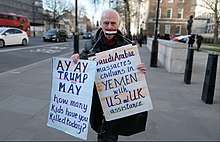
The approval of the 2017 arms deal was opposed by various lawmakers, including GOP Senators Mike Lee, Rand Paul, Todd Young and Dean Heller along with most Democrat Senators who voted to advance the measure in order to block the sale, citing the human rights violations by Saudi Arabia in the Yemeni Civil War.[61][62] Among the senators who voted against moving the measure to block the sale were Democratic Senators Joe Donnelly, Claire McCaskill, Bill Nelson, Joe Manchin and Mark Warner along with top Republicans, including Majority Leader Mitch McConnell, Bob Corker and John McCain.[63]
Tulsi Gabbard — a Democratic Representative from Hawaii — criticized the move, saying that Saudi Arabia is "a country with a devastating record of human rights violations at home and abroad, and a long history of providing support to terrorist organizations that threaten the American people".[64][65] Rand Paul introduced a bill to try to block the plan calling it a "travesty".[66][67][68]
U.S. Senator Chris Murphy accused the United States of complicity in Yemen's humanitarian crisis, saying: "Thousands and thousands inside Yemen today are dying. ... This horror is caused in part by our decision to facilitate a bombing campaign that is murdering children and to endorse a Saudi strategy inside Yemen that is deliberately using disease and starvation and the withdrawal of humanitarian support as a tactic."[69]
In October 2018, serious allegations were put on Saudi for murdering a Washington Post columnist Jamal Khashoggi inside the Saudi consulate in Istanbul. US Secretary of State Mike Pompeo urged Saudi Arabia to "support a thorough investigation" regarding the disappearance and "to be transparent about the results."[70] Trump said, "We cannot let this happen to reporters, to anybody. We're demanding everything. We want to see what's going on there."[71]
Lindsey Graham, a senior Republican senator’s reaction was stern, as he said "there would be hell to pay" if Saudi is involved in the murder of Khashoggi. He further added, "If they're this brazen it shows contempt. Contempt for everything we stand for, contempt for the relationship."[72]
2016 U.S. presidential election
In August 2016, Donald Trump Jr. had a meeting with an envoy representing Saudi Arabia's Crown Prince and de facto ruler Mohammad bin Salman, and Mohammed bin Zayed Al Nahyan, the Crown Prince of Abu Dhabi. The envoy offered help to the Trump presidential campaign.[73] The meeting included Lebanese-American lobbyist George Nader, Joel Zamel, an Israeli specialist in social media manipulation, and Blackwater founder Erik Prince.[74][73]
Post-9/11 relationship
.jpg)
Saudi Arabia engaged the Washington, D.C., lobbying firm of Patton Boggs as registered foreign agents in the wake of the public relations disaster when knowledge of the identities of suspected hijackers became known. They also hired the PR and lobbying firm Qorvis for $14 million a year. Qorvis engaged in a PR frenzy that publicized the "9/11 Commission finding that there was 'no evidence that the Saudi government as an institution or senior Saudi officials individually funded [Al Qaeda]'—while omitting the report's conclusion that 'Saudi Arabia has been a problematic ally in combating Islamic extremism.'"[75][76]
According to at least one journalist (John R. Bradley), the ruling Saudi family was caught between depending for military defense on the United States, while also depending for domestic support on the Wahhabi religious establishment, which as a matter of religious doctrine "ultimately seeks the West's destruction", including that of its ruler's purported ally—the US. [77] During the Iraq War, Saudi Foreign Minister Prince Saud Al-Faisal, criticized the U.S.-led invasion as a `colonial adventure` aimed only at gaining control of Iraq's natural resources.[78] But at the same time, Bradley writes, the Saudi government secretly allowed the US military to "essentially" manage its air campaign and launch special operations against Iraq from inside Saudi borders, using "at least three" Saudi air bases.[79]
The two nations cooperate and share information about al-Qaeda (Alsheikh 2006) and leaders from both countries continue to meet to discuss their mutual interests and bilateral relations.[80]
Saudi Arabia and the U.S. are strategic allies,[81][82] and since President Obama took office in 2009, the U.S. has sold $110 billion in arms to Saudi Arabia.[83][84] The National Security Agency (NSA) in 2013 began cooperating with the Saudi Ministry of Interior in an effort to help ensure "regime continuity". An April 2013 top secret memo shows the agency's program of providing "direct analytic and technical support" to the Saudis on "internal security" matters. The CIA had already been gathering intelligence for the regime long before.[85]
In January 2015, after the death of King Abdullah, the White House and President Obama praised him as a leader and mentioned "the importance of the U.S.-Saudi relationship as a force for stability and security in the Middle East and beyond.”[86]
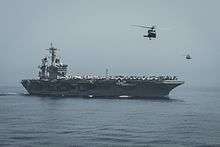
In March 2015, President Barack Obama declared that he had authorized U.S. forces to provide logistical and intelligence support to the Saudis in their military intervention in Yemen, establishing a "Joint Planning Cell" with Saudi Arabia.[88] U.S. government lawyers have considered whether the United States is legally a "co-belligerent" in the conflict. Such a finding would oblige the U.S. to investigate allegations of war crimes by the Saudi coalition, and U.S. military personnel could be subject to prosecution.[89][90]
American journalist Glenn Greenwald wrote in October 2016: "From the start of the hideous Saudi bombing campaign against Yemen 18 months ago, two countries have played active, vital roles in enabling the carnage: the U.S. and U.K. The atrocities committed by the Saudis would have been impossible without their steadfast, aggressive support."[91]
In September 2016, Senators Rand Paul and Chris Murphy worked to prevent the proposed sale of $1.15 billion in arms from the U.S. to Saudi Arabia.[92] The U.S. Senate voted 71 to 27 against the Murphy–Paul resolution to block the U.S.–Saudi arms deal.[93]
In January 2017, U.S. Secretary of Defense James Mattis "reaffirmed the importance of the U.S.-Saudi Arabia strategic relationship".[94] Mattis has voiced support for a Saudi Arabian-led military campaign against Yemen's Shiite rebels.[95][96] He asked the President Trump to remove restrictions on U.S. military support for Saudi Arabia.[97] On 10 February 2017, CIA director Mike Pompeo awarded the Saudi Crown Prince Muhammad bin Nayef with the CIA's “George Tenet” Medal.[98]
In 2018, during a fundraising event in Washington, Trump took a dig at the Saudi king. He described the king as “right out of central casting” (according to Merriam-Webster dictionary, “central casting” is a phrase used to refer to “people stereotypical of their role in appearance, behavior, or nature”). Trump had also refused to bow to the king during his interaction with him in 2017.[99]
Notable diplomatic visits
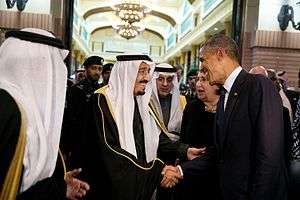
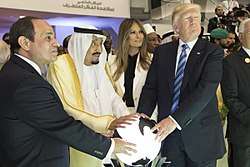
After President George W. Bush's two visits to Saudi Arabia in 2008—which was the first time a U.S. president visited a foreign country twice in less than four months—and King Abdullah's three visits to the US—2002, 2005 and 2008—the relations have surely reached their peak. The two nations have expanded their relationship beyond oil and counter terrorism efforts. For example, King Abdullah has allocated funds for young Saudis to study in the United States.[100] One of the most important reasons that King Abdullah has given full scholarships to young Saudis is to give them western perspective and to impart a positive impression of Saudi Arabia on the American people (Alslemy, 2008). On the other hand, President Bush discussed the world economic crisis and what the U.S.–Saudi relationship can do about it (Tabassum, 2008). During meetings with the Saudis, the Bush Administration took the Saudi policies very seriously because of their prevalent economic and defensive presence in the region and its great media influence on the Islamic world (Al Obaid 2007). By and large, the two leaders have made many decisions that deal with security, economics, and business aspects of the relationship, making it in the top of its fame. (Gearan, 2008)
2017 US–Saudi Arms Deal
US President Donald Trump authorized a nearly $110B arms deal with Saudi Arabia, worth $300B over a ten-year period, signed on the 20 May 2017, this includes training and close co-operation with the Saudi Arabian military.[101] Signed documents included letters of interest and letters of intent and no actual contracts.[102]
US defense stocks reached all-time highs after Donald J. Trump announced a $110 billion arms deal to Saudi Arabia.[103][104][105]
Saudi Arabia signed billions of dollars of deals with U.S. arms producers and energy companies, including Lockheed Martin, Boeing, Raytheon, General Dynamics, Northrop Grumman, General Electric, Exxon Mobil, Halliburton, Honeywell, McDermott International, Jacobs Engineering Group, Rowan Companies, National Oilwell Varco, Nabors Industries, Weatherford International, Schlumberger and Dow Chemical.[106][107][108][109][110][111]
In August, 2018, a laser-guided Mark 82 bomb sold by the U.S. and built by Lockheed Martin was used in the Saudi-led coalition airstrike on a school bus in Yemen, which killed 51 people, including 40 children.[112]
See also
References
- ↑ Henderson, Simon. "The Long Divorce; How the U.S.-Saudi relationship grew cold under Barack Obama's watch". April 19, 2016. Foreign Policy. Retrieved 25 April 2016.
- ↑ Keating, Joshua (6 November 2017). "The Fight for Survival Behind Saudi Arabia's Purge". Retrieved 1 February 2018 – via Slate.
- ↑ Gardner, Frank (20 April 2016). "How strained are US-Saudi relations?". BBC News.
- ↑ "The bizarre alliance between the US and Saudi Arabia is finally fraying". www.newstatesman.com.
- ↑ "The U.S. Might Be Better Off Cutting Ties With Saudi Arabia". Time.
- ↑ Sokоlsky, Perry Cammack, Richard. "The New Normal in U.S.-Saudi Relations". The National Interest.
- ↑ "Shifting Sands in the U.S.-Saudi Arabian Relationship | Middle East Policy Council". www.mepc.org.
- 1 2 BBC World Service Poll GlobeScan
- 1 2 Stokes, Bruce. "Which countries Americans like … and don't". December 30, 2013. pewresearch.org. Retrieved 16 April 2014.
- ↑ Cordesman, Anthony H. (December 31, 2002). Saudi Arabia Enters The 21st Century: IV. Opposition and Islamic Extremism Final Review (PDF). CSIS. pp. 11–12. Retrieved 26 November 2015.
- ↑ TOP 25 PLACES OF ORIGIN OF INTERNATIONAL STUDENTS Institute of International Education
- 1 2 3 4 5 6 7 Grayson, Benson Lee (1982). Saudi-American relations. University Press of America.
- 1 2 "Chronology". PBS. Retrieved 11 August 2013.
- ↑ I. Andrew (28 February 1998). "Ambassador Parker T. Hart (1910-1997)". Washington Report on Middle East Affairs. XI (5). Retrieved 20 January 2014. – via Questia (subscription required)
- 1 2 3 4 5 6 Pollack, Josh (September 2002). "SAUDI ARABIA AND THE UNITED STATES, 1931-2002" (PDF). Middle East Review of International Affairs. 6 (2). Retrieved 23 October 2014.
- ↑ Metz, Helen Chapin, ed. (1992). Saudi Arabia: A Country Study. GPO for the Library of Congress.
- 1 2 Metz, Helen Chapin (1993). Saudi Arabia : a country study. Library of Congress. Federal Research Division.
- 1 2 3 4 Hart, Parker T. (1998). Saudi Arabia and the United States: Birth of a Security Partnership. Indiana University Press. Retrieved 23 October 2014.
- 1 2 F. Gregory Gause, III (2010). The International Relations of the Persian Gulf. Cambridge University Press. p. 22. ISBN 0521190231. Retrieved 25 December 2013.
- ↑ F. Gregory Gause, III (2010). The International Relations of the Persian Gulf. Cambridge University Press. p. 21. ISBN 0521190231. Retrieved 25 December 2013.
- ↑ http://www-personal.umich.edu/~twod/oil-ns/articles/research-07/research-saudi/pollack.pdf
- ↑ F. Gregory Gause, III (2010). The International Relations of the Persian Gulf. Cambridge University Press. p. 31. ISBN 0521190231. Retrieved 25 December 2013.
- ↑ F. Gregory Gause, III (2010). The International Relations of the Persian Gulf. Cambridge University Press. pp. 38–39. ISBN 0521190231. Retrieved 25 December 2013.
- ↑ Coll, Steve (2004). Ghost Wars: The Secret History of the CIA, Afghanistan, and Bin Laden, from ... Penguin. Retrieved 23 October 2014.
- 1 2 Ottaway, David B.; Kaiser, Robert G. (Feb 13, 2002). "Marriage of Convenience: The U.S.-Saudi Alliance". Washington Post.
- ↑ Rashid, Nasser Ibrahim (1992). Saudi Arabia and the Gulf War. Intl Inst of Technology Inc.
- 1 2 "US pulls out of Saudi Arabia". BBC News. April 29, 2003. Retrieved 29 November 2009.
- ↑ Plotz, David (2001) What Does Osama Bin Laden Want?, Slate
- ↑ "Arms for the King and His Family: The U.S. Arms Sale to Saudi Arabia". Jerusalem Center For Public Affairs. Retrieved 24 April 2016.
- ↑ "US-Saudi Security Cooperation, Impact of Arms Sales – Cordesman". Retrieved 24 April 2016.
- ↑ The King's Messenger: Prince Bandar bin Sultan and America's Tangled ... By David B Ottaway
- ↑ House, Karen Elliott (2012). On Saudi Arabia : Its People, Past, Religion, Fault Lines and Future. Knopf. p. 238.
- ↑ Said, Summer; Benoit Faucon (July 29, 2013). "Shale Threatens Saudi Economy, Warns Prince Alwaleed". The Wall Street Journal. Retrieved November 5, 2013.
- ↑ "Saudi to reassess relations with US: report". Retrieved 24 April 2016.
- ↑ Worth, Robert F. (October 18, 2013). "Saudi Arabia Rejects U.N. Security Council Seat in Protest Move". New York Times. Retrieved November 5, 2013.
- ↑ Balluck, Kyle (November 28, 2013). "Obama, Saudi king to 'consult regularly' on Iran". The Hill. Retrieved December 2, 2013.
- ↑ CARTER, SHAN (September 8, 2011). "One 9/11 Tally: $3.3 Trillion". New York Times. Retrieved 27 October 2014.
- ↑ Friedman, Thomas (June 2, 2002). "War of Ideas". New York Times. Retrieved 30 April 2014.
The idea people who inspired the hijackers are religious leaders, pseudo-intellectuals, pundits, and educators, primarily in Egypt and Saudi Arabia, which continues to use its vast oil wealth to spread its austere and intolerant brand of Islam, Wahhabism.
- ↑ Bradley, John R. (2005). Saudi Arabia Exposed. Macmillan. p. 6.
- ↑ Michael R. Dillon (September 2009). "Wahhabism: Is it a Factor in the Spread of Global Terrorism?" (PDF). NAVAL POSTGRADUATE SCHOOL. Archived from the original (PDF) on April 18, 2014.
The events that transpired on September 11, 2001, shook the foundation of the U.S.-Saudi relationship by raising serious concerns and questions regarding the role of the Saudi government and their Wahhabi ideology played in terrorism associated with Al-Qaeda. The attacks shined a light on Saudi Arabia since 15 out of 19 hijackers as well as Osama bin Laden and many of the global ”jihadists” that participated in the conflicts fought in Bosnia, Chechnya, Afghanistan, and Iraq were Saudi nationals. This naturally led the U.S. government and its people to ask serious questions as to what is wrong with Saudi Arabia and to draw conclusions about its religious ideology and institutions.
- ↑ Chair: Maurice R. Greenberg,. "Task Force Report Terrorist Financing". October 2002. Council on Foreign Relations. Retrieved 17 May 2014.
- ↑ Rodenbeck, Max (October 21, 2004). "Unloved in Arabia (book reviews)". The New York Review of Books. 51 (16).
Judging by the tenor of much that has been said about Saudi Arabia since September 11, quite a few people seem to think something similar should be done with the present-day Saudis. In Congress, on American television, and in print, their country has been portrayed as a sort of oily heart of darkness, the wellspring of a bleak, hostile value system that is the very antithesis of our own. America's seventy-year alliance with the kingdom has been reappraised as a ghastly mistake, a selling of the soul, a gas-addicted dalliance with death.
- ↑ Lacey, Robert (2009). Inside the Kingdom : Kings, Clerics, Modernists, Terrorists, and the Struggle for Saudi Arabia. Viking. pp. 288–9.
"In July that year [2002?] Laurent Murawiec, a French analyst with the RAND Corporation, had given a 24-slide presentation to the prestigious Defense Policy Board, an arm of the Pentagon, suggesting that the United States should consider 'taking [the ]Saudi out of Arabia' by forcibly seizing control of the oil fields, giving the Hijaz back to the Hashemites, and delegating control of the holy cities to a multinational committee of moderate, non-Wahhabi Muslims: the House of Saud should be sent home to Riyadh. 'Saudi Arabia supports our enemies and attacks our allies,' argued Murawiec, a protege of Richard Perle's, the neocon advocate of war with Iraq who chaired the Policy Board. 'The Saudis are active at every level of the terror chain, from planners to financiers, from cadre to foot soldier, from ideologist to cheerleaders.' They were 'the kernel of evil, the prime mover, the most dangerous opponent' in the Middle East.
- ↑ Cordesman, Anthony H.; Al-Rodhan, Khalid R. (2007). Gulf Military Forces in an Era of Asymmetric Wars. Greenwood Publishing Group.
- ↑ Bradley, John R. (2005). Saudi Arabia Exposed : Inside a Kingdom in Crisis. Palgrave. p. 169.
In the climate of intense anti-American sentiment in Saudi Arabia after September 11, it is certainly true that any association with U.S.-inspired `reform` ... is fast becoming a hindrance rather than a help.
- ↑ Bradley, John R. (2005). Saudi Arabia Exposed : Inside a Kingdom in Crisis. Palgrave. p. 211.
Anti-U.S. sentiment inside Saudi Arabia is now at an all-time high, following the outrages at the Abu Ghraib prison in Baghdad and Washington's continued support for Israel's often brutal suppression of the Palestinians.
- ↑ SCIOLINO, ELAINE (January 27, 2002). "Don't Weaken Arafat, Saudi Warns Bush". New York Times. Retrieved 20 October 2014.
A classified American intelligence report taken from a Saudi intelligence survey in mid-October [2001] of educated Saudis between the ages of 25 and 41 concluded that 95 percent of them supported Mr. bin Laden's cause, according to a senior administration official with access to intelligence reports.
- ↑ "Saudi Arabians Overwhelmingly Reject Bin Laden, Al Qaeda, Saudi Fighters in Iraq, and Terrorism; Also among most pro-American in Muslim world. Results of a New [2006] Nationwide Public Opinion Survey of Saudi Arabia" (PDF). Terror Free Tomorrow. Retrieved 20 October 2014.
- ↑ Bradley, John R. (2005). Saudi Arabia Exposed : Inside a Kingdom in Crisis. Palgrave. p. 85.
In a region obsessed with conspiracy theories, many Saudis, both Sunni and Shiite, think that Washington has plans to split off the Eastern Province into a separate entity and seize control of its oil reserves after Iraq has stabilized.
- ↑ "Frontline Saudi Arabia". PBS.org. Retrieved 23 October 2014.
- ↑ Rich, Frank (December 7, 2002). "Pearl Harbor Day, 2002". New York Times. Retrieved 17 May 2014.
... spokesman for our ally Saudi Arabia who on Tuesday declared that his country was the victim of unwarranted American intolerance bordering on hate. ... the Saudi minister of the interior, Prince Nayef, maintained as recently as last week that the 15 Saudi hijackers of 9/11 were dupes in a Zionist plot.
- ↑ Timothy Maier (2002-06-24). "Kids Held Hostage in Saudi Arabia" (PDF). Insight. Retrieved 2010-08-31.
- ↑ Timothy Maier (2001-11-27). "Stolen Kids become Pawns in Terror War" (PDF). Insight. Retrieved 2010-08-31.
- ↑ Timothy Maier (2001-06-18). "All Talk, No Action on Stolen Children" (PDF). Insight. Retrieved 2010-08-31.
- ↑ Timothy Maier (2000-10-07). "A Double Standard for Our Children" (PDF). Insight. Retrieved 2010-08-31.
- ↑ Spillius, Alex (5 December 2010). "Wikileaks: Saudis 'chief funders of al-Qaeda'". London: Telegraph. Retrieved 28 April 2011.
- ↑ 'Fueling Terror', Institute for the Analysis of Global Terror, http://www.iags.org/fuelingterror.html
- ↑ "Why Obama doesn't want 9/11 families suing Saudi Arabia". USA Today. September 23, 2016.
- ↑ "Saudi Arabia threatens to pull $750B from U.S. economy if Congress allows them to be sued for 9/11 terror attacks". New York Daily News. April 16, 2016.
- ↑ "Mayor de Blasio joins Democrats in calling on President Obama to go after Saudi Arabia on 9/11 ties". New York Daily News. April 19, 2016.
- ↑ Liautaud, Alexa (June 13, 2017). "The Senate-approved Saudi Arms deal is a disaster for Yemen". Vice News. Retrieved 14 June 2017.
- ↑ Cooper, Helene (13 June 2017). "Senate Narrowly Backs Trump Weapons Sale to Saudi Arabia". The New York Times. Retrieved 14 June 2017.
- ↑ Carney, Jordain (13 June 2017). "Senate rejects effort to block Saudi arms sale". The Hill. Retrieved 14 June 2017.
- ↑ "Gabbard condemns arms sale to Saudi Arabia | Asian American Press". aapress.com. Retrieved 2017-05-21.
- ↑ Beavers, Olivia (2017-05-20). "Dem senator: Trump's arms deal with Saudis a 'terrible idea'". TheHill. Retrieved 2017-05-21.
- ↑ Hensch, Mark (2017-05-23). "Paul plans to force vote on $110B Saudi defense deal". TheHill. Retrieved 2017-05-26.
- ↑ "Senators Target Trump's Proposed $110B Weapons Deal With Saudi Arabia". 25 May 2017. Archived from the original on 2017-06-19.
- ↑ Hensch, Mark (2017-05-24). "Paul: $110B Saudi arms deal 'a travesty'". TheHill. Retrieved 2017-05-27.
- ↑ "Congress Votes to Say It Hasn’t Authorized War in Yemen, Yet War in Yemen Goes On". The Intercept. 14 November 2017.
- ↑ "Jamal Khashoggi: Britain challenges Saudi Arabia". BBC News. Retrieved 10 October 2018.
- ↑ "Jamal Khashoggi: Trump 'demands answers' on missing Saudi". BBC News. Retrieved 10 October 2018.
- ↑ "Jamal Khashoggi disappearance: 'Hell to pay' for Saudi Arabia if journalist was murdered, Lindsey Graham says". The Independent. Retrieved 10 October 2018.
- 1 2 "Trump Jr. and Other Aides Met With Gulf Emissary Offering Help to Win Election". The New York Times. 19 May 2018.
- ↑ "Trump Jr. met Gulf princes' emissary in 2016 who offered campaign help". Reuters. 19 May 2018.
- ↑ Kurlantzick, Joshua (2007-05-07). "Putting Lipstick on a Dictator". Mother Jones. Retrieved 2007-08-22.
- ↑ Lichtblau, Eric (March 1, 2011). "Arab Uprisings Put U.S. Lobbyists in Uneasy Spot". The New York Times.
- ↑ Bradley, John R. (2005). Saudi Arabia Exposed : Inside a Kingdom in Crisis. Palgrave. p. 213.
The ruling Al-Saud family has long sought ... to be the ally of the West, especially of the United States, while both influencing it and keeping its corrupting influences at bay, and simultaneously backing a Wahhabi establishment it relies on to remain in power but which also ultimately seeks the West's destruction...
- ↑ Bradley, John. "Waiting in the shadows" (3–9 June 2004). AL-AHRAM. Retrieved 24 October 2014.
- ↑ Bradley, John R. (2005). Saudi Arabia Exposed : Inside a Kingdom in Crisis. Palgrave. pp. 210–11.
[the Gulf War was] aimed only at gaining control of Iraq's natural resources. While that argument could be made quite strongly by anyone else, it is a bit rich coming from any member of the Al-Saud family. During the Iraq war, Saudi Arabia secretly helped the United States by allowing operations from at least three air bases, permitting special forces to stage attacks from Saudi soil, and providing cheap fuel. The American air campaign against Iraq was essentially managed from inside Saudi borders, where military officers operated a command center and launched refueling tankers, F-16 fighter jets, and sophisticated intelligence-gathering flights.
- ↑ "Saudi-US Economic Relations 3 Riyadh". May 16, 2017. Saudi Press Agency. Retrieved 19 May 2017.
- ↑ "How strained are US-Saudi relations?". BBC News. 20 April 2016.
- ↑ "Old friends US and Saudi Arabia feel the rift growing, seek new partners". Asia Times. 2 May 2016.
- ↑ "America Is Complicit in the Carnage in Yemen". The New York Times. 17. August 2016.
- ↑ "Rights group blasts U.S. “hypocrisy” in “vast flood of weapons” to Saudi Arabia, despite war crimes". Salon. 30. August 2016.
- ↑ "The NSA’s New Partner in Spying: Saudi Arabia’s Brutal State Police" Glenn Greenwald, The Intercept, July 25, 2014
- ↑ Los Angeles Times (22 January 2015). "King Abdullah, 90, of Saudi Arabia dies; Obama offers condolences for 'candid' leader - LA Times". latimes.com. Retrieved 24 April 2016.
- ↑ "U.S. carrier moving off the coast of Yemen to block Iranian arms shipments". USA Today. 20 April 2015.
- ↑ "Saudi Arabia launches air attacks in Yemen". The Washington Post. 25 March 2015.
- ↑ Warren Strobel, Jonathan Landay (10 October 2016). "Exclusive: As Saudis bombed Yemen, U.S. worried about legal blowback". Reuters.
- ↑ Nathalie Weizmann (27 March 2015). "International Law on the Saudi-Led Military Operations in Yemen". Just Security.
- ↑ "U.S. and U.K. Continue to Actively Participate in Saudi War Crimes, Targeting of Yemeni Civilians". The Intercept. October 10, 2016.
- ↑ "Senators consider vote to block US arms deal to Saudi Arabia – report". The Guardian. 14 August 2016.
- ↑ "Senate rejects bill blocking U.S.-Saudi arms deal; rights groups applaud "growing dissent" on Yemen war crimes". Salon. 21 September 2016.
- ↑ "Readout of Secretary Mattis' Call with Kingdom of Saudi Arabia's Deputy Crown Prince and Minister of Defense Mohammed bin Salman". U.S. Department of Defense. January 31, 2017.
- ↑ "Pentagon Weighs More Support for Saudi-led War in Yemen". Foreign Policy. March 26, 2017.
- ↑ "America's Support for Saudi Arabia's War on Yemen Must End". The Nation. April 5, 2017.
- ↑ "Trump administration weighs deeper involvement in Yemen war". The Washington Post. March 26, 2017.
- ↑ Bethan McKernan, "CIA awards Saudi crown prince with medal for counter-terrorism work", The Independent, 10 February 2017
- ↑ "Trump 'ATTACKED US allies' at fundraiser as he took aim at Saudi Arabia, Canada and EU". Daily Express. Retrieved 4 October 2018.
- ↑ "The King Abdullah Scholarship Program". Saudi Cultural Bureau in Canada. Retrieved 19 May 2017.
- ↑ David, Javier E. (20 May 2017). "US-Saudi Arabia ink historic 10-year weapons deal worth $350 billion as Trump begins visit". Retrieved 1 February 2018.
- ↑ Riedel, Bruce (5 June 2017). "The $110 billion arms deal to Saudi Arabia is fake news". Retrieved 1 February 2018.
- ↑ "U.S. defense stocks jump on Saudi arms deal". Retrieved 2017-05-27.
- ↑ Thomas, Lauren (2017-05-22). "Defense stocks soar to all-time highs on $110 billion US-Saudi Arabia weapons deal". CNBC. Retrieved 2017-05-27.
- ↑ CNBC (2017-05-22). "After Saudi arms deal, defense shares fly". CNBC. Retrieved 2017-05-27.
- ↑ "Factbox: Deals signed by U.S. companies in Saudi Arabia". Reuters. May 20, 2017.
- ↑ "Saudi Arabia Welcomes Trump With Billions of Dollars of Deals". Bloomberg. May 20, 2017.
- ↑ "Guide to $400 Billion in Saudi-U.S. Deals: Black Hawks to Oil". Bloomberg. May 22, 2017.
- ↑ "Aramco signs $50-billion in deals with US companies". Oil & Gas Journal. May 22, 2017.
- ↑ "4 Defense Giants In Buy Zone As Saudis Near $100 Billion Arms Package". Investor's Business Daily. May 19, 2017.
- ↑ "5 Top Deals Lockheed, Boeing, Raytheon May Get From Saudis — If They Pay Up ". Investor's Business Daily. June 9, 2017.
- ↑ Elbagir, Nima, Salma Abdelaziz, Ryan Browne, Barbara Arvanitidis and Laura Smith-Spark (August 14, 2018). "Bomb that killed 40 children in Yemen was supplied by US". CNN.
![]()
External links
| Wikimedia Commons has media related to Relations of Saudi Arabia and the United States. |
